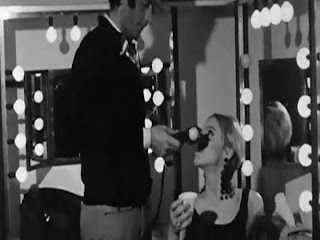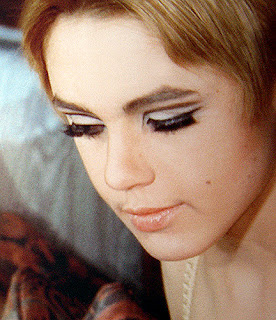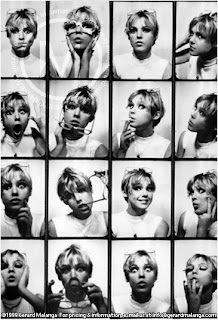STEPHEN KOCH: “Edie was unique among the women superstars because she never played the female clown. All the others – Baby Jane Holzer in the grotesquerie of her voguishness; Ingrid Superstar, a perfectly conscious comedienne forever varying on the theme of the dumb blond; Tiger Morse (who appeared more often at Max’s Kansas City than in films), camping and squealing like a schoolgirl; Viva, with her interminable frizzy-haired account of schizophrenia, lascivious priests, and a badly damaged female ego – all of them were in one way or another involved in a more or less comic display of their fears and weaknesses and overcompensations as women. But Sedgwick always kept her cool. When she spoke she made sense; her response to a contretemps on screen was never the customary hysteria but a visibly intelligent effort to cope… As a woman, Edie Sedgwick had what used to be called class.”
ULTRA VIOLET: “Glamour she inhales, glamour she exhales.”
DAVID DALTON: “Edie wanted things to conform to the little theater in her head – the world being what it is, that didn’t always happen. She was ready to take her imaginary kingdom, the one that had first blossomed at Rancho La Laguna, into the real world. The glamorous freak, the King’s Daughter, the Princess of Pop with her multi-colored pills. The child in full tutu bursting after dinner into her parents’ party to perform her ballet dance from Swan Lake. Isn’t she adorable! A little doll! The little doll who never grew up. That was a huge part of Edie’s charm.”
BILLY NAME: “It’s balletic, it was a magic kind of thing. She expected everyone else to be wonderful, by nature. It wasn’t like a pretense, or you’re supposed to be wonderful with Edie, it was more like her attitude was ‘Everyone I meet in the world is going to be absolutely wonderful, and we’re all going to have a beautiful, smooth, wonderful time.’ She was on a little cloud all the time, holding on to a lightning bolt. She welcomed everyone that way, and if you weren’t that way, in a sense she was disappointed… But she... took it in stride, if that’s what the world is like and maybe we don’t put our wings on today.”
DONALD LYONS: “The two of us, over the time we knew each other, exchanged parts of a story, the adventures of a strange golden creature that the two of us would write chapters on… it was the story of a golden girl escaping from the green giants, and so forth, that were out to capture and devour her.”
DAVID DALTON: “Neon Edie: a black tights, black light, thigh-high-booted imp of the perverse. She was riveting to look at. Tights, nasty boots, hoop earrings, a razor-cut cap of streaked blond hair, big Betty Boop eyes magnified by the brain-scan buzz of amphetamines, and smoking, smoking, smoking, as if that’s the way people breathed on her planet.”
BILLY NAME: “The leotards and the shirt, I mean, that’s what every girl wants. That’s all you need in the world. It was like the underground version of the little black dress and pearls.”
BILLY NAME: “Chuck Wein had great insight but he would do such horrible things. He almost destroyed Edie. She was a semi-polished uncut diamond, and he cut her the wrong way. Even if you see [“Beauty #2] and he’s off-screen, he’s constantly challenging her. And it became so tedious to her that it wore her out. He was trying to make her prove something. He was trying to make her into a witty, more clever person, always capable of taking on any challenge. And it was unnecessary because her poise, her very presence was so wonderful. A lot of it has to do with amphetamines at the time. People would become so zealous about who they were. Chuck would become ten-times-Chuck, super Chuck!”
ROBERT HEIDE: “She gave off this eerie light and energy. It’s as if Edie was illuminated from within. Her skin was translucent; Marilyn Monroe had that quality.”
ED HENNESSY: “She wore earrings that resembled chandeliers and necklaces that Tutankhamen and Babe Paley would have envied. She look like a hooker from Mars.”
DAVID DALTON: “Social life revolved around her as it had done in the years before she left home. Wherever she went she was the center of attention, a Copernican system, where she was the charismatic solar deity around whom everything revolved. As long as her charisma magnetized the gravity in the room, it was her movie. She was so charming (and slightly addled) that people granted her the floor. She spun and spun them around her.”
ONDINE: “Those were the days I lived in Central Park. I’d wake up by the lakes and swim in them. Then I’d go to the West Side, where I had a couple of opera friends who did nothing but listen to music and shoot up, and after that to Edie’s. When I got up there, she’d start coming to and ask if I had any amphetamine. In her leotards she’d start doing her exercises. She would open the I Ching. We threw an I Ching, the two of us collectively, and it was called ‘Pushing Upward, No. 46.’ It was a difficult one and very strange. When we played the I Ching, I put on her earrings. Then she’d go to the Victrola and play Joan Sutherland’s ‘Traviata’ and next I’d play Callas’ ‘Traviata’ just to see, then we’d play the Beatles. And phone calls, every minute there were phone calls. Dates. People. Thousands of people who wanted her to do layouts for this and that.”
CHERRY VANILLA: “The first half hour after a speed shot was dangerous, because you often got a sudden urge to shop, buy someone a gift, spend the rent money on something pretty. And right across the street from Dr. Bishop’s 53rd street office was a shop called Hunter’s World and, oh my God, how many elephant-hair bracelets and zebra-skin notebooks could anyone possibly need? (This was long before PETA, of course). The other temptation was a nearby crystal and rock shop, where it was especially hard to resist the colorful sparklers.”
DAVID DALTON: “Late lunch at L’Aventura. Her favorite restaurant (near Bloomingdale’s) is host to lunch for eight to twelve people, with Edie picking up the tab. Then mad shopping expeditions, charging mountains of clothes, jewelry, ransacking cosmetics departments like a Mongol horde. An astounding amount of clothes – often buying the same outfit twice.”
PAUL MORRISSEY: “Andy’s whole life was one endless photo opportunity. He couldn’t go out by himself, and when he had Edie he started to get real photo opportunities. She was good for that, and also, people don’t quite realize this, she almost always picked up the check for Andy.”
GERARD MALANGA: “Baby Jane Holzer, she represents a certain pop culture. What can we say Edie represents? She may just represent a transition into something better and more extraordinary and fantastic.”
EDIE SEDGWICK: “I didn’t know I was replacing Jane. In fact, I’d never even heard of her. I hardly ever read the papers. I am not trying to create an image or a following. I act this way because that’s the way I feel like acting. If people like it – fine. If they don’t – that’s their problem.”
ANDY WARHOL: “[Edie] invented the mini-skirt. She was trying to prove to her family that she could live on nothing, so she would go to the Lower East Side and buy the cheapest clothes, which happen to be little girls’ skirts, and her waist was so tiny she could get away with it. Fifty cents a skirt. She was the first person to wear ballet tights as a complete outfit, with big earrings to dress it up. She was an innovator – out of necessity as well as fun – and the big fashion magazines picked up on her look right away.”
PATTI SMITH: “When I was a young girl I got a job at a factory to help pay for my education. On lunch breaks I would sit by myself and devour discarded fashion magazines. They provided a window to a world that was not immediately accessible to a girl growing up in rural South Jersey. In an issue of Vogue from August 1965, a photograph of another Factory girl caught my eye. A so-called Youthquaker named Edie Sedgwick. Something about her image was liberating. A self-possessed little minx in black tights poised on a leather rhino, ballet-style. The outline of a horse was sketched upon the wall. She projected playful yet concentrated, irreverent energy. So full of life, falling into no category. Who was she? What did she do? She was herself. She did it all. I tore out the picture and tacked it on my wall alongside John Lennon, Maria Callas, and Arthur Rimbaud. A new muse reminding me to stay on track. To stay in balance. I had dreams of getting out of New Jersey, and like the girl in the picture, I was on the edge, ready to fly.”
STEVEN WATSON: “Through fashion magazines Edie Sedgwick inspired other women. Some wanted her rail-thin energy; others responded to her insouciant little-girl beauty. She was sexy but not sexually threatening, and she could be both Pop and haute. Even in a small and crowded discotheque, Edie stood out from the other dancers in their Pucci slacks, hip-hugger denims, and Mod dresses. In her bangles and leotards she was the perfect package for the Sixties revolution in fashion.”
JOHN PALMER: “Iconic, as if she was some sort of figure… Madonna, Mary. It was as if she was some kind of an icon in that sense, and that all of that was going to explode, and she’s acting out through all of that, about to fall off the altar and go into a thousand pieces.”
DONALD LYONS: “I think you just wanna be the person who gets the moon.”
EDIE: “I’m already half there… and I didn’t choose it either.”





































































































































































































